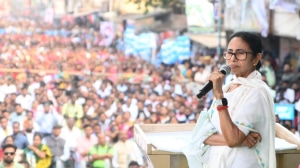Click here to join Express Pune WhatsApp channel and get a curated list of our stories
Maharashtra records 181 cases of heat stroke over April–May
No mention of climate change in election dialogue, experts pitch for policies to consider heat as parameter
 April has seen one of the longest spells of heatwave extending up to 15 days (File Photo)
April has seen one of the longest spells of heatwave extending up to 15 days (File Photo)While the Election Commission of India (ECI) had taken necessary action by constituting a task force to deal with the impact of intense heatwave on voters, experts rue the fact that there has been no mention of climate change in the election dialogue, despite India being heatwave prone for the last several years now.
Roxy Mathew Koll, senior scientist, Indian Institute of Tropical Meteorology, Pune, said “Although authorities concerned are doing their best as compared with earlier times, we still do not have policies that consider heat as a major parameter.”
“For instance, Pune has been reeling under high temperatures but schools are still open. This is because there is no policy for this in the city as it does not fall under heatwave-prone zones. Similarly, there are no policies for labour too. We need to work on policies that have a provision to cut down on working hours. We are no longer in a situation where we can ignore the impacts of climate change.”
Mercury has been swinging between 42–45 degrees Celsius, even soaring to 47 degrees Celsius in some parts of the country. April has seen one of the longest spells of heatwave extending up to 15 days and according to Koll, data clearly points at a rise in density, frequency, duration and area covered by the heatwave due to global warming.
With no immediate relief from the stifling heat, officials have again advised caution, and ahead of polling across Baramati, Satara, Sangli and other constituencies on May 7, they have set up medical first aid kits at polling stations.
Maharashtra health authorities have reported a total of 181 heat stroke cases from March 1 till April 30 this year. March this year saw a total of 27 cases of heat stroke while April recorded as many as 154 persons affected by heat stroke. The highest number of cases were in Nashik (21) Chandrapur (20), Wardha (19) and 10 each in Jalna and Sindhudurg. Solapur reported 13 cases of heat stroke while Pune reported 7 cases of heat stroke.
According to Climate Central, a US research organisation, 36 of 51 major Indian cities had three or more days above the 37°C threshold since voting began, while 18 cities experienced over 40°C for more than three days in April.
Urban heat island effect
Dr Harshal Salve, additional professor, Community Medicine, AIIMS, New Delhi, told The Indian Express that increasing construction activity and concrete roads are some of the factors that have led to the urban heat island effect. Local civic bodies must implement dust settling measures like sprinkling water on the roadside.
Dr Harshal Pandve, professor and head, Department of Community Medicine, Pimpri Chinchwad YCM, said that an urban heat island (UHI) occurs when a city experiences much warmer temperatures than rural areas nearby. “The difference in temperature between urban and less-developed rural areas has to do with how well the surfaces in each environment absorb and hold heat. With climate change and so much construction in urban and semi-urban areas, this UHI phenomenon is going to worsen. We need to be proactive to deal with it,” he added.
Effect on health
Experts say that severe heat waves can exacerbate chronic health conditions, vector-borne diseases, air pollution, drought and other socio-economic pressures that can result in higher mortality and morbidity. Heatwaves with severe consequences have increased and are expected to become more frequent in Indian climatic and geographical conditions. As per the future projection studies, temperatures could rise ±1.2° C to ±3.5° C and will start reducing only by the end of 2050.
Click here to join Express Pune WhatsApp channel and get a curated list of our stories








